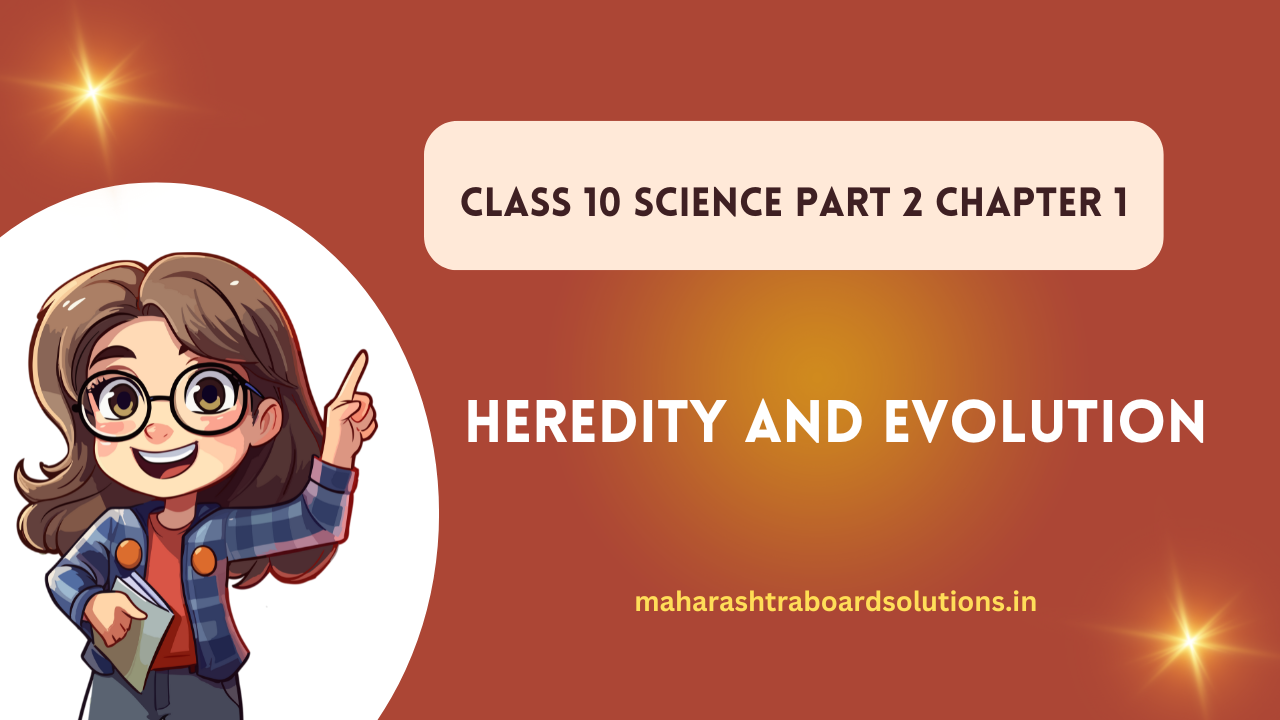Balbharti Maharashtra State Board Class 10 Science Solutions Part 2 Chapter 1 Heredity and Evolution Notes, Textbook Exercise Important Questions and Answers.
Std 10 Science Part 2 Chapter 1 Heredity and Evolution Question Answer Maharashtra Board
Class 10 Science Part 2 Chapter 1 Heredity and Evolution Question Answer Maharashtra Board
Question 1.
Complete the following diagram.
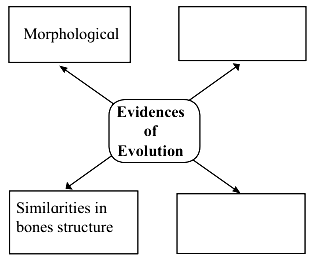
Answer:
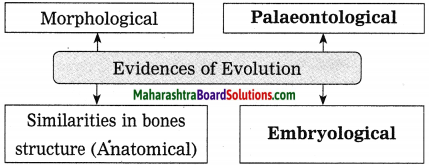
Question 2.
Read the following statements and justify same in your own words with the help of suituble examples.
a. Human evolution began approximately 7 crore years ago.
Answer:
- Approximately around 7 crore years back the ice age began on the earth. In such conditions, dinosaurs became extinct. The evolution and diversity of mammals started during this time. Due to change in climate the forest cover also declined rapidly.
- Ancestors of monkey-like animals were Lemur like animals which evolved during this time period.
- The tails of these monkey-like creatures started vanishing very gradually around 4 crore years ago.
- The body and brain both increased in volume forming first ape like animals. The monkey like ancestors gave rise to two evolutionary links to apes and human like animals.
- Later, the human evolution took place by changes in the brain volume, the ability to walk upright, excessive use of hand for manipulations.
- This journey of human evolution began 7 crore years ago. But the true wise and intelligent man arose around 50,000 years ago.
b. Geographical and reproductive isolation of organisms gradually leads to speciation.
Answer:
- Every species survives in specific geographical conditions. The requirements of food and habitat, is specific for each species. Their reproductive ability and period is also different.
- Therefore, the individuals from one species cannot reproduce with individuals from other species.
- When they are separated by a distance or geographical barriers they are said to be isolated geographically.
- When they cannot reproduce with each other, they are said to be isolated reproductively.
- The ancestor species of both these subspecies may be the same but due to isolation over a very long-time duration, there is genetic variation between the two. Therefore, the isolation leads to speciation.
c. Study of fossils is an important aspect of study of evolution.
Answer:
Answer:
- Fossils offer palaeontological evidence for the evolutionary process.
- Due to some natural calamities the organisms get buried during ancient times.
- The impressions and remnants of such organisms remain preserved underground. The hot lava also traps some organisms or their impressions. All such formations form fossils.
- Study of fossils help the researcher to understand the characteristics of the organisms that existed in the past.
- Carbon dating method also helps in finding out exact age of the fossil. According to the structure of earth’s crust the fossils are obtained at specific depths.
- The oldest ones are obtained at the depth while the relatively recent ones occupy the upper surface. Thus fossils of invertebrates were seen in very old Palaeozoic era. Later were seen fossils of Pisces, Amphibia and Reptilia. The Mesozoic era was dominated by reptiles while Coenozoic era showed presence of mammals.
- In this way, study of fossils unfold the evolutionary secrets.
d. There is evidences of fatal Science among chordates.
[Please read the above question as: Among different chordates there are embryological evidences.]
Answer:
- Very young embryos of fish, amphibians, reptiles, birds and mammals show quite similar structure in the early stages.
- As the further growth takes place, they acquire different patterns.
- The initial similarity between the vertebrate embryos is an evidence that during evolution, there was a common ancestor for all the vertebrate classes.
- This is called embryological evidence for vertebrate evolution.
![]()
Question 3.
complete the statements by choosing correct options from bracket.
(Genes, Mutation, Translocation, Transcription, Gradual development, Appendix)
a. The causality behind the sudden changes was understood due to ………… principle of Hugo de Vries.
Answer:
Mutation
b. The proof for the fact that protein synthesis occurs through ……….. was given by George Beadle and Edward Tatum.
Answer:
Genes
c. Transfer of information from molecule of DNA to mRNA is called as …………… process.
Answer:
Transcription
d. Evolution means ………….
Answer:
Gradual development
e. Vestigial organ ……….. present in human body is proof of evolution.
Answer:
Appendix
Question 4.
Write short notes based upon the information known to you.
a. Lamarckism.
Answer:
(1) Lamarckism consists of two theories which were proposed by Jean Baptiste Lamarck. These are as follows: (a) Use and disuse of the organs (b) Inheritance of acquired characters.
(2) In theory of use and disuse of organs, Lamarck says : The characters of organs develop because specific activities that the organisms perform. If such organ is not used it gets degenerated. Thus the morphological changes take place due to activities or inactivity of a particular organism.
(3) To emphasise this theory, he quoted following examples. Due to constant extension of neck to eat foliage from the top of the trees, giraffe’s neck became long. Similarly blacksmith has strong arms due to constant work. Flightless ostrich and emu did not fly and hence their wings became useless. Aquatic birds like swan and duck made their feet suitable for swimming by living in water. Snake lost limbs as it tried burrowing mode.
(4) Such acquired characters are passed from one parental generation to the offspring. This is called inheritance of acquired characters.
(5) The theory of inheritance of acquired characters is not accepted as such transmission of acquired character does not take place. Only genetic characters are transmitted.
b. Darwin’s theory of natural selection.
Answer:
- Charles Darwin proposed the theory of natural selection after making many observations on different specimens. He published a concept ‘Survival of the fittest’.
- Darwin explains this concept as follows: All the organisms reproduce prolifically. Therefore, there is always a competition for food, mate, etc. Only adaptations for sustaining this struggle.
- Natural selection plays important role by selecting only those organisms which are fit to live. Those that do not have better adaptations, perish. Selected sustaining organisms then perform reproduction and form new species in a very long period of time.
- Darwin published his views in the book titled ‘Origin of Species’.
c. Embryology.
Answer:
- Embryology is the study of developing embryos.
- These embryos in their initial stages are very similar to each other.
- These similarities decrease later in the development.
- This similarity in initial stages indicate that these vertebrates have originated from a common ancestor.
- In evolutionary science, comparative study of embryos of various vertebrates provide evidence for evolution.
d. Evolution.
Answer:
- The sequential changes in the groups of living organisms that take place very gradually is called evolution.
- Evolution is also described as the formation of new species due to natural selection.
- The process of evolution takes millions of years for development and speciation of different organisms.
- Changes in stars and planets in space and the changes in biosphere occurring on the Earth are all included under study of evolution.
- Due to evolution organisms become fit, biodiversity is increased, and new species are created.
- Different scientists have put forth theories to explain the process of evolution. Among these Charles Darwin’s theory of natural selection and speciation is accepted worldwide.
e. Connecting link.
Answer:
Some living organisms possess some characters in them which are the distinctive features of different groups or phyla. Such individuals connect these two groups by sharing the characters of both and hence they are known as connective links.
Examples: (1) Peripatus: Peripatus is the connecting link between Annelida and Arthropoda. It shows characters of both animal phyla. Like annelid worm, it shows segmented body, thin cuticle and parapodia. Like an arthropod, it shows open circulatory system and tracheal system for respiration.
(2) Duck Billed platypus: This is a connecting link between reptiles and mammals. Like reptiles it lays eggs but like mammals it has mammary glands and hairy skin.
(3) Lung fish: Lung fish is a connecting link between fishes and amphibians. Though a fish, it shows lungs for respiration as in amphibian animals.
(4) Connecting links indicate the direction and hierarchy of evolution.
![]()
Question 5.
Define heredity. Explain the mechanism of hereditary changes.
Answer:
(1) Heredity: Heredity is the process by which the biological characters from parental generation are transmitted to the next generation through genes.
(2) The mechanism of hereditary changes:
- Mutation: Sudden change in the parental DNA can cause mutations. This results into changes in the hereditary characters.
- At the time of meiosis, the crossing over takes place. This creates new recombination of the genetic information. Therefore, the haploid gametes produced carry changed hereditary characters.
Question 6.
Define vestigial organs. Write names of some vestigial organs in human body and write the names of those animals in whom same organs are functional.
Answer:
- Vestigial organs are degenerated or underdeveloped organs of organisms which do not perform any function.
- According to the principle of natural selection, such organs are on the verge of disappearance. But it takes many millions of years for its complete vanishing.
- The vestigial organs in one animal may be of use but to other kind of the animal as they still perform regular functions.
- Appendix is vestigial for humans, it does not perform any function but in ruminant animals it is concerned with digestion.
- Ear muscles are vestigial for us but in monkeys and cattle they are functional.
- Names of vestigial organs in human body-Appendix, tail-bone or coccyx, wisdom teeth and body hair.
Question 7.
Answer the following questions.
a. How are the hereditary changes responsible for evolution?
Answer:
Hereditary characters are transmitted from parental generation to the offspring. These characters are maintained through inheritance. But the genes which are beneficial for the organisms in helping them to adapt to the environment are transmitted to the next generations in a greater proportion. This happens due to natural selection.
The process of evolution happens at a very slow pace. The favourable genes are preserved in the species as they bring about better survival of the individuals. Such individual reproduces more efficiently and evolve. The individuals with unfavourable genes are not selected by nature and are thus removed from the population through natural death. The fuel for evolution is thus truly supplied by the hereditary changes.
b. Explain the process of formation of complex proteins.
Answer:
The proteins are synthesised in following steps, viz. transcription, translation and translocation. Protein synthesis takes place according to the sequence of nucleotides present on the DNA molecule with the help of RNA molecules. This is known as central dogma of protein synthesis.
1. Transcription: In the process of transcription, mRNA is produced as per the nucleotide sequence on the DNA. For this the two strands DNA are separated. Only one strand participates in the formation of mRNA. The sequence of nucleotides which is complementary to that of present on DNA is copied on mRNA. Instead of thymine present in DNA, uracil is added on the mRNA. Transcription takes place in nucleus but the mRNA leaves nucleus, carries the genetic code and enters the cytoplasm. This genetic code is always in triplet form arid hence is known as triplet codon. The code for each amino acid always consists of three nucleotides.
2. Translation: Each mRNA may carry thousands of codons. But each codon is specific for only one amino acid. The tRNA molecule brings the required amino acid as per the code present on mRNA. There is anticodon on each tRNA which is complementary to the codon on mRNA. This process is known as translation.
3. Translocation: In translocation, the ribosome keeps on moving from one end of mRNA molecule to other end by distance of one triplet codon. While this process is taking place, rRNA, helps in joining the amino acids together by peptide bonds. The peptide chains later come together to form complex protein molecules.
c. Explain the theory of evolution and mention the proof supporting it.
Answer:
1. Theory of evolution:
- According to the theory of evolution, first living material was in the form of protoplasm which was formed in ocean.
- Gradually, it gave rise to unicellular organisms. Changes took place in these unicellular organisms which made them evolve into larger and more complex organisms.
- All evolutionary changes were very slow and gradual taking about 300 crore years to happen.
- Different types of organisms were developed as the changes and development that occurred in living organisms wefts all round and multi-dimensional.
- Hence, this overall process of evolution is called organizational and progressive.
- Variety of plants and animals developed from the ancestors having different structural and functional organization during the process of evolution.
2. Proof here means evidences of evolution.
These evidences are as follows:
- Morphological evidences
- Anatomical evidences
- Vestigial organs
- Palaentological evidences
- Connecting links
- Embryological evidences.
d. Explain with suitable examples importance of anatomical evidences in evolution. (July 2019)
Answer:
- There are similarities in the structure and anatomy of different animal groups. E.g. human hand, forelimb of bull, patagium of bat and flipper of whale are all similar in their internal anatomy. There is similarity in the bones and joints of all these specimens.
- External morphology does not show any similarity. Use of each of the organ is also different in different animals. Structurally, they may not be related.
- However, the similarities in the anatomy is an evidence that they may have a common ancestor.
- In this way, the anatomical evidence throws light on the process of evolution.
e. Define fossil. Explain importance of fossils as proof of evolution.
Answer:
- Fossils offer palaeontological evidence for the evolutionary process.
- Due to some natural calamities the organisms get buried during ancient times.
- The impressions and remnants of such organisms remain preserved underground. The hot lava also traps some organisms or their impressions. All such formations form fossils.
- Study of fossils help the researcher to understand the characteristics of the organisms that existed in the.past.
- Carbon dating method also helps in finding out exact age of the fossil. According to the structure of earth’s crust the fossils are obtained at specific depths.
- The oldest ones are obtained at the depth while the relatively recent ones occupy the upper surface. Thus fossils of invertebrates were seen in very old Palaeozoic era. Later were seen fossils of Pisces, Amphibia and Reptilia. The Mesozoic era was dominated by reptiles while Coenozoic era showed presence of mammals.
- In this way, study of fossils unfold the evolutionary secrets.
f. Write evolutionary history of modern man.
Answer:
(1) Ancestors of humans developed from animals which resembled lemur like animals.
(2) Around seven crore years ago, monkey-like animals evolved from some of these lemur like animals.
(3) Then after about 4 crore years ago, in Africa the tails of these monkey like creatures very gradually disappeared.
(4) Simultaneously, there was enlargement in their body and brain volume too. The hands also improved and were provided with opposable thumb. In this way, ape-like animals were evolved.
(5) These ape-like animals independently gave rise to two lines of evolution, one giving rise to apes like gibbon and orangutan in the South and North-East Asia and gorilla and chimpanzee which stayed in Africa around 2.5 crores of years ago.
(6) The other line of evolution gave rise to human like animals around 2 crore years ago.
(7) The climate became dry and this resulted into reduction of forest cover. This made arboreal apes to descend on the land and start terrestrial mode.
(8) Due to this, there were changes in the pefvic
girdle and vertebral column. The hands were also freed from locomotion and thus they became more manipulative.
(9) Later, journey of hominoid species started from around 2 crores years ago. The first record of human like animal is ‘Ramapithecus’ ape from East Africa.
(10) Ramapithecus → Australopithecus → Neanderthal man → Cro-Magnon are the important steps in human evolution.
(11) Neanderthal man was said to be the first wise man. The increasing growth of brain made man more and more intelligent and thinking animal.
(12) Later, more than biological evolution, it was cultural evolution, when man started agriculture, animal , rearing. There was development of civilizations, arts and science etc. About 200 years ago there were industrial inventions and thus man now rules the earth.
Project:
Project 1.
Make a presentation on human evolution using various computer softwares and arrange a group disscussion over it in the class room.
Project 2.
Read the book – ‘Pruthvivur Manus Uparcich’ written by Late Dr. Sureshchandra Nadkarni and note your opinion on evolution.
![]()
Can you recall? (Text Book Page No. 1)
Question 1.
Which component of the cellular nucleus of living organisms carries hereditary characters?
Answer:
The chromosomes made up of nucleic acids and proteins, present in the nucleus of the cell are the components that carry hereditary characters in living organisms.
Question 2.
What do we call the process of transfer of physical and mental characters from parents to the progeny?
Answer:
The process of transfer of physical and mental characters from parents to the progeny is called inheritance or heredity.
Question 3.
Which are the components of the DNA molecule?
Answer:
DNA molecule is made up of two helical strands consisting of deoxyribose sugar, phosphoric acid and pairs of nitrogenous bases. These three together is called a nucleotide.
Choose the correct alternative and write its alphabet against the sub-question number:
Question 1.
Darwin has published a book titled …………..
(a) Natural selection
(b) Mutation
(c) Fall of a sparrow
(d) Origin of species
Answer:
(d) Origin of species
Question 2.
The …………. man evolved about 50 thousand years ago.
(a) Cro Magnon
(b) Neanderthal
(c) Java man
(d) Ramapithecus
Answer:
(a) Cro Magnon
Question 3.
About 10 thousand years ago, ………….. started to practise agriculture.
(a) Gorilla
(b) wise man
(c) Ramapithecus
(d) Australopithecus
Answer:
(b) wise man
Question 4.
………………. can be considered as the first example of wise-man.
(a) Australopithecus
(b) Ramapithecus
(c) Cro Magnon
(d) Neanderthal man
Answer:
(d) Neanderthal man
Question 5.
………. is a connecting link between Annelida and Arthropoda. (March 2019)
(a) Duck-billed platypus
(b) Peripatus
(c) Lung fish
(d) Whale
Answer:
(b) Peripatus
Question 6.
………… years ago human brain was sufficiently evolved to call him wise man.
(a) 50,000
(b) 30,000
(c) 20,000
(d) 10,000
Answer:
(a) 50,000
Question 7.
The process by which the gene in the nucleotide suddenly changes its position is called ………. (Board’s Model Activity Sheet)
(a) translation
(b) translocation
(c) mutation
(d) transcription
Answer:
(c) mutation
![]()
Question 8.
…………. is not the vestigial organ in the human body. (Board’s Model Activity Sheet)
(a) appendix
(b) Coccyx
(c) Canine
(d) Wisdom teeth
Answer:
(c) Canine
Write whether the following statements are true or false with proper justification for your answer:
Question 1.
It takes thousands of years for a useful structure to disappear.
Answer:
False. (The useful structures of the body do not disappear. The functioning of the body is easier due to such organs. It takes thousands of years for a functionless organ to disappear.)
Question 2.
Dr. Har Govind Khorana was awarded Nobel prize for his invention and publication in the journal Radio carbon.
Answer:
False. (Willard Libby was awarded Nobel prize for his invention and publication in the journal Radio carbon.)
Question 3.
Mesozoic era was dominated by variety of mammals.
Answer:
False. (Mesozoic era dominated by variety of reptiles.)
Question 4.
It seems that invertebrates have been slowly originated from vertebrates.
Answer:
False. (Vertebrates have been slowly originated from invertebrates in course of evolution. The primitive type of organisms always give rise to complex life forms. The invertebrates from Palaeozoic era gradually gave rise to vertebrates.)
Question 5.
The decaying process of C-12 occurs continuously from the dead remains of living organisms.
Answer:
False. (The decaying process of C-14 occurs continuously from the dead remains of living organisms. C-12 is not radioactive and hence it does not show decaying process.)
Question 6.
The theory of natural selection which mentions ‘Survival of fittest’ is given by Lamarck.
Answer:
False. (The theory of natural selection which mentions ‘Survival of fittest’ is given by Darwin.)
Question 7.
Changes acquired during life time are transferred to next generation.
Answer:
False. (Changes acquired during life time are not heritable. They are not transferred to next generation. Only the genes are transferred to the next generation.)
Question 8.
Each species grows in specific geographical conditions and has specific food, habitat, reproductive ability and period.
Answer:
True. (Each species has specifically evolved characters due to evolution and speciation.)
Question 9.
Humans walking with upright posture were confined to Africa only during prehistoric period.
Answer:
False. (Humans walking upright existed in Africa and China, Indonesia of Asian continent too.)
![]()
Question 10.
Industrial society was established about 200 years ago.
Answer:
True. (After the development and specialization of human brain, he started indulging in science and technology. Before; this period the idea of industrialization was not existing.)
Match the columns:
Question 1.
| Scientist | Discovery |
| (1) Johann Gregor Mendel | (a) Chromosomes of grasshopper |
| (2) Hugo de Vries | (b) DNA is genetic material |
| (c) Pioneer of the modern genetics | |
| (d) Mutational theory |
Answer:
(1) Johann Gregor Mendel – Pioneer of the modern genetics.
(2) Hugo de Vries – Mutational theory.
Question 2.
| Scientist | Discovery |
| (1) Walter, Sutton | (a) Chromosomes of grasshopper |
| (2) Mclyn McCarthy | (b) DNA is genetic material |
| (c) Pioneer of the modern genetics | |
| (d) Mutational theory |
Answer:
(1) Walter, Sutton – Chromosomes of grasshopper.
(2) Mclyn McCarthy – DNA is genetic material.
Question 3.
| Evidences of evolution | Examples |
| (1) Morphological evidences | (a) Duck billed Platypus and Peripatus |
| (2) Anatomical evidences | (b) Remnants and impressions |
| (c) Human hand and fore limb of bull | |
| (d) Shape and venation of leaf |
Answer:
(1) Morphological evidences – Shape and venation of leaf.
(2) Anatomical evidences – Human hand and fore limb of bull.
![]()
Question 4.
| Evidences of evolution | Examples |
| (1) Palaeontological evidences | (a) Duck billed Platypus and Peripatus |
| (2) Connecting links | (b) Remnants and impressions |
| (c) Coccyx and wisdom tooth | |
| (d) Human hand and fore limb of cat |
Answer:
(1) Palaeontological evidences – Remnants and impressions.
(2) Connecting links – Duck billed Platypus and Peripatus.
Find the odd one out:
Question 1.
Transcription, Translation, Translocation, Mutation
Answer:
Mutation. (All others are stages of protein synthesis.)
Question 2.
Bones of the hands, structure of nostrils, position of eyes, structure of ear pinnae
Answer:
Bones of the hands. (All the others are morphological evidences.)
Question 3.
Venation, Shape of seeds, Leaf petiole, Leaf shape
Answer:
Shape of seeds. (All the others are morphological evidences in plants.)
Question 4.
Human hand, wing of cockroach, forelimb of bull, flipper of whale
Answer:
Wing of cockroach. (All others are anatomical evidences, they are homologous organs.)
Identify the correlation between the first two words and suggest the suitable words in the fourth place:
Question 1.
mRNA : Transcription :: tRNA :…………
Answer:
Translation
Question 2.
Peripatus : Connecting link :: Appendix :……….
Answer:
Vestigial organs
Question 3.
Open circulatory system : Arthropods :: Thin cuticle and parapodia :………..
Answer:
Annelida
Question 4.
Between Annelida and Arthropoda : Peripatus ::……….: Lungfish
Answer:
Pisces/Fish and Amphibia
Question 5.
Theory of natural selection : Charles Robert Darwin :: Theory of inheritance of acquired characters :…………
Answer:
Jean Baptiste Lamarck
![]()
Question 6.
Survival of fittest : Darwin :: Acquired characters :……….
Answer:
Lamark
Question 7.
Wisdom teeth : Vestigial organs :: Lungfish :………..
Answer:
Connecting link.
Define the following:
Question 1.
Heredity.
Answer:
The transfer of biological characters from one generation to another through genes is called heredity.
Question 2.
Transcription.
Answer:
Question 3.
Translation.
Answer:
The process of bringing tRNA possessing anticodon that is complementary to the codon on mRNA for protein synthesis is called translation.
Question 4.
Translocation.
Answer:
The process of movement of the ribosome from one end of mRNA to other end by the distance of one triplet codon is called translocation.
Question 5.
Mutation.
Answer:
Sudden and drastic change that occurs in the genetic material is called mutation.
Question 6.
Species.
Answer:
The group of organisms that cap produce fertile individuals through natural reproduction is called a species.
Name the following:
Question 1.
Three Scientists who proved that except viruses, all living organisms have DNA as genetic material.
Answer:
Oswald Avery, Mclyn McCarthy and Colin MacLeod.
Question 2.
Genetic disorder caused due to mutation:
Answer:
Sickle cell anaemia.
Question 3.
Fish that can breathe with help of lungs:
Answer:
Lung fish.
Question 4.
Vestigial organs in human beings:
Answer:
Appendix, tail-bone or coccyx, wisdom teeth and body hair.
![]()
Question 5.
Important stages in the journey of human evolution:
Answer:
- Animals like Lemur
- Egyptopithecus
- Dryopithecus
- Ramapithecus
- Australopithecus
- Skilled Human
- Homo erectus i.e. Man with erect posture
- Neanderthal man
- Cro-Magnon man.
Distinguish between the following:
Question 1.
Transcription and Translation.
Answer:
Transcription:
- In the process of transcription, the sequence of nucleotides present on the DNA molecule is copied
and carried to the cytoplasm by mRNA. - The process of transcription takes place in nucleus.
- During transcription, RNA is produced from DNA.
- Only mRNA takes part in transcription.
Translation:
- In the process of translation, the specific amino acids are picked up according to the codons brought by mRNA.
- The process of translation takes place in ribosomes located in cytoplasm.
- During translation, proteins are produced with the help of RNA.
- mRNA, tRNA and rRNA take part in translation.
Question 2.
Ape and Human.
Answer:
Ape:
- Brain of the apes is smaller in size.
- Ape cannot walk upright.
- Ape is less intelligent as compared to human.
- Apes are arboreal in their habitat and they spend more time on the trees.
- The forelimbs of ape are longer than the hind limbs.
Human:
- Brain of humans is larger in size.
- Humans can walk upright.
- Human is considered to be the most intelligent animal.
- Humans are terrestrial in their habitat. They cannot stay on the trees.
- The forelimbs of humans are shorter than the hind limbs.
Give scientific reasons:
Question 1.
Some of the characters of parents are seen in their offspring.
Answer:
- The parental genes are transferred to their progeny through male and female gametes.
- These genes carry hereditary characters.
- Since they are transmitted from the parents to their offspring, one can see the parental characters in their offspring.
Question 2.
Darwin’s work on evolution has been a milestone.
Answer:
(1) Darwin has proposed two very important theories of evolution, viz. Theory of natural selection and Theory of origin of species.
(2) The evolution has taken place on the earth for last many crores of years.
(3) The exact nature and process of these evolutionary changes become clear after studying Darwinism. (4) The observations made by Darwin at that time are now tested according to the modern development in science and are found to be correct. Thus, his work is said to be a milestone.
Question 3.
Peripatus is said to be a connecting link between Annelida and Arthropoda.
Answer:
- Peripatus shows segmented body, thin cuticle, and parapodia-like organs.
- These characters are typical of Annelids.
- Similarly, it also shows tracheal respiration and open circulatory system which is a characteristic feature of Arthropods.
- Since Peripatus shares both these characters, it is said to be a connecting link between j Annelida and Arthropoda.
Question 4.
Vertebrates have been slowly originated from invertebrates.
Answer:
- When the carbon dating method was used to assess the age of fossils, it was understood that invertebrates were present on the earth much before the vertebrates.
- The fossils of invertebrates are present in lower layers of earth’s strata.
- They were seen in Palaeozoic era of geological time period. Vertebrates dominated during Coenozoic era.
- Their fossils are seen in the upper strata of the earth’s crust.
- The structural complexity also increased in vertebrates. All these facts indicate that Vertebrates have slowly originated from invertebrates.
Question 5.
During human evolution the hands became available for use.
Answer:
- During human evolution, the climate of earth started becoming dry.
- This resulted in loss of forest cover.
- The apes which were arboreal on the trees thus descended and started walking on land.
- The lumbar bones underwent change and the apes started walking upright on the grasslands.
- The vertebral column also underwent change. Due to upright posture the forelimbs were freed from locomotion.
- The legs started bearing the weight of the body and the hands became available for use.
Read the following statements and justify the same in your own words with the help of suitable examples:
Question 1.
Geographical and reproductive isolation of organisms gradually leads to speciation.
Answer:
- Every species survives in specific geographical conditions. The requirements of food and habitat, is specific for each species. Their reproductive ability and period is also different.
- Therefore, the individuals from one species cannot reproduce with individuals from other species.
- When they are separated by a distance or geographical barriers they are said to be isolated geographically.
- When they cannot reproduce with each other, they are said to be isolated reproductively.
- The ancestor species of both these subspecies may be the same but due to isolation over a very long-time duration, there is genetic variation between the two. Therefore, the isolation leads to speciation.
![]()
Question 2.
Study of fossils is an important aspect of study of evolution.
Answer:
(1) Fossils offer palaeontological evidence for the evolutionary process.
(2) Due to some natural calamities the organisms get buried during ancient times.
(3) The impressions and remnants of such organisms remain preserved underground. The hot lava also traps some organisms or their impressions. All such formations form fossils.
(4) Study of fossils help the researcher to understand the characteristics of the organisms that existed in the.past.
(5) Carbon dating method also helps in finding out exact age of the fossil. According to the structure of earth’s crust the fossils are obtained at specific depths.
(6) The oldest ones are obtained at the depth while the relatively recent ones occupy the upper surface. Thus fossils of invertebrates were seen in very old Palaeozoic era. Later were seen fossils of Pisces, Amphibia and Reptilia. The Mesozoic era was dominated by reptiles while Coenozoic era showed presence of mammals.
(7) In this way, study of fossils unfold the evolutionary secrets.
Question 3.
There is evidences of fatal Science among chordates.
[Please read the above question as: Among different chordates there are embryological evidences.]
Answer:
- Very young embryos of fish, amphibians, reptiles, birds and mammals show quite similar structure in the early stages.
- As the further growth takes place, they acquire different patterns.
- The initial similarity between the vertebrate embryos is an evidence that during evolution, there was a common ancestor for all the vertebrate classes.
- This is called embryological evidence for vertebrate evolution.
Question 4.
Human evolution began approximately 7 crore years ago.
Answer:
- Approximately around 7 crore years back the ice age began on the earth. In such conditions, dinosaurs became extinct. The evolution and diversity of mammals started during this time. Due to change in climate the forest cover also declined rapidly.
- Ancestors of monkey-like animals were Lemur like animals which evolved during this time period.
- The tails of these monkey-like creatures started vanishing very gradually around 4 crore years ago.
- The body and brain both increased in volume forming first ape like animals. The monkey like ancestors gave rise to two evolutionary links to apes and human like animals.
- Later, the human evolution took place by changes in the brain volume, the ability to walk upright, excessive use of hand for manipulations.
- This journey of human evolution began 7 crore years ago. But the true wise and intelligent man arose around 50,000 years ago.
Answer the following questions:
Question 1.
Answer the following questions: (March 2019)
(a) What do you mean by central dogma?
Answer:
Information about protein synthesis is present in DNA. As per this information, proteins are produced by DNA through RNA molecules. This is called central dogma.
(b) What is transcription?
Answer:
The process of synthesis of mRNA as per the nucleotide sequence present in DNA is called transcription. The nucleotide sequence on mRNA is complimentary to that of the single DNA strand used in synthesis. Instead of thymine, mRNA possesses uracil.
(c) What is meant by triplet codon?
Answer:
The code for each amino acids always consists of three nucleotides which is known as triplet codon.
Question 2.
Which animal is called a connecting link between Reptiles and Mammals? (Board’s Model Activity Sheet)
Answer:
Duck billed platypus is called a connecting link between Reptiles and Mammals.
Question 3.
In which way is science of heredity useful these days?
Answer:
The science of heredity is useful in the following ways:
- For diagnosis of hereditary disorders.
- For treatment of hereditary disorders
- For prevention of hereditary disorders
- For production of hybrid varieties of animals and plants
- For using microbes in the industrial processes.
![]()
Question 4.
What is meant by carbon dating method?
Answer:
(1) Carbon dating method is technique used for determining the age of fossils.
(2) After the death of the organisms, their consumption of carbon stops. But right from that moment the decaying process of C-14 occurs continuously.
(3) This results in change in the ratio between C-14 and C-12. C-12 is not radioactive as C-14.
(4) Thus the time passed since the death of a plant or animal is calculated by measuring the radioactivity of C-14 and ratio of C-14 to C-12 present in their body.
(5) The points noted during carbon dating are:
- The period after the organism has been dead.
- The activity of C-14 in the dead organism.
- Ratio between C-14 and C-12.
Question 5.
Answer the following questions:
(a) Describe briefly the Darwin’s theory of natural selection.
Answer:
Charles Darwin (1809-1882) proposed the theory of natural selection.
Theory of natural selection: ‘The survival of fittest’, i.e., organisms which are fit for survival, evolve while those that are not, perish. The natural selection thus acts to produce new species.
(b) What were the objections raised against Darwinism?
Answer:
Objections raised against Darwinism:
- There are other factors too for evolution and just not the Natural Selection.
- Arrival of useful and useless modifications were not explained by Darwin, though he said about the survival of the fittest.
- He has not given any explanation about slow changes and abrupt changes occurring during evolution.
(c) Which book was published by Darwin to explain this theory? (Board’s Model Activity Sheet)
Answer:
Charles Darwin wrote the book ‘Origin of Species’.
Question 6.
What were the objections raised against Darwinism?
Answer:
Some of the main objections raised against Darwinism are as follows:
- There are other factors too for evolution and just not the Natural Selection.
- Arrival of useful and useless modifications were not explained by Darwin, though he said about the survival of the fittest.
- He has not given any explanation about slow changes and abrupt changes occurring during evolution.
Question 7.
Answer the following questions:
(a) Explain in brief-Lamarck’s principle of ‘use or disuse of organs’.
Answer:
The theory of use and disuse of organs says that the morphological characters of organism develop because of specific activities that the organisms perform. If some organ is not used it gets degenerated. If excessively, used, it develops. Thus, the morphological changes take place due to activities or non-working of a particular body parts in an organism.
(b) Give two examples.
Answer:
Due to constant extension of neck to eat foliage from the top of the trees, giraffe’s neck became long. Similarly, blacksmith has strong arms due to constant work. The flightless ostrich and emu did not fly and hence their wings became useless. Aquatic birds like swan and duck made their feet suitable for swimming by living in water. Snake lost limbs as it tried burrowing mode.
(c) What are acquired characters?
Answer:
Acquired characters are those characters which are obtained during the life time by any organism and passed on to next generations.
Write short notes:
(OR)
Write short notes based upon the information known to you:
Question 1.
Theory of evolution.
Answer:
- According to the theory of evolution, first living material was in the form of protoplasm which was formed in ocean.
- Gradually, it gave rise to unicellular organisms. Changes took place in these unicellular organisms which made them evolve into larger and more complex organisms.
- All evolutionary changes were very slow and gradual taking about 300 crore years to happen.
- Different types of organisms were developed as the changes and development that occurred in living organisms was all round and multi-dimensional.
- Hence, this overall process of evolution is called organizational and progressive.
- Variety of plants and animals developed from the ancestors having different structural and functional organization during the process of evolution.
By choosing appropriate words given in the bracket, complete the paragraph:
Question 1.
(translation, anticodon, tRNA, mRNA, amino acids, triplet codon, transcription, DNA)
The …….. formed in nucleus comes in cytoplasm. It brings in the coded message from DNA. The message contains the codes for amino acids. The code for each amino acid consists of three nucleotides. It is called as ‘………..’. Each mRNA is made up of thousands of triplet codons. As per the message on mRNA, ……… are supplied by the ………. For this purpose, tRNA has ‘…………’ having complementary sequence to the codon on mRNA. This is called ‘………..’.
Answer:
The mRNA formed in nucleus comes in cytoplasm. It brings in the coded message from DNA. The message contains the codes for amino acids. The code for each amino acid consists of three nucleotides. It is called as ‘triplet codon’. Each mRNA is made up of thousands of triplet codons. As per the message on mRNA, amino acids are supplied by the tRNA. For this purpose, tRNA has ‘anticodon’ having complementary sequence to the codon on mRNA. This is called ‘translation’.
![]()
Question 2.
(Cultural, agriculture, fire, brain, Cro-Magnon, Homo sapiens, Neanderthal)
Evolution of upright man continued in the direction of developing its ………. for the period of about 1 lakh years and meanwhile he discovered the ………. Brain of man, 50 thousand years ago had been sufficiently evolved to the extent that it could be considered as member of the species ………… Neanderthal man can be considered as the first example of wise-man. The ……….. man evolved about 50 thousand years ago and afterwards, this evolution had been faster than the earlier. About 10 thousand years ago, wise-man started to practise the ………. It started to rear the cattle-herds and established the cities. ………..development took place later.
Answer:
Evolution of upright man continued in the direction of developing its brain for the period of about 1 lakh years and meanwhile he discovered the fire. Brain of man 50 thousand years ago had been sufficiently evolved to the extent that it could be considered as member of the species Homo sapiens. Neanderthal man can be considered as the first example of wise-man. The Cro-Magnon man eyolved about 50 thousand years ago and afterwards, this evolution had been faster than the earlier. About 10 thousand years ago, wise-man started-to practise the agriculture. It started to rear the cattle-herds and established the cities. Cultural development took place later.
Read the paragraph and answer the questions given below:
With the help of RNA, the genes present in the form of DNA participate in the functioning of cell and thereby control the structure and functioning of the body. Information about protein synthesis is stored in the DNA and synthesis of appropriate proteins as per requirement is necessary for body. These proteins are synthesized by DNA through the RNA. This is called ‘Central Dogma’. mRNA is produced as per the sequence of nucleotides on DNA. Only one of the two strands of DNA is used in this process. The sequence of nucleotides in mRNA being produced is always complementary to the DNA strand used for synthesis. Besides, there is uracil in RNA instead of thymine of DNA. This process of RNA synthesis is called ‘transcription’.
Questions and Answers:
Question 1.
Which part of the cell control the structure and functioning of the body?
Answer:
Genes present in the form of DNA along with RNA control the structure and functioning of the body.
Question 2.
How is a specific protein synthesised in the cell?
Answer:
The information of protein synthesis is stored in the DNA which is utilised as per the requirement of the body. Later the proteins are synthesised by DNA through the RNA.
Question3.
What is the similarity between mRNA and DNA?
Answer:
The sequence of nucleotides on DNA is copied on mRNA. The nucleotide sequence on mRNA is thus complementary to DNA.
Question 4.
Give one difference between RNA and DNA.
Answer:
RNA has uracil instead of thymine which is present in DNA.
Question 5.
Define central dogma.
Answer:
Central dogma is the concept that proteins are synthesised by DNA through the RNA.
Diagram-based questions:
Question 1.
Observe the figure 1.3 of transcription given on page 9 in this chapter and answer the following questions:
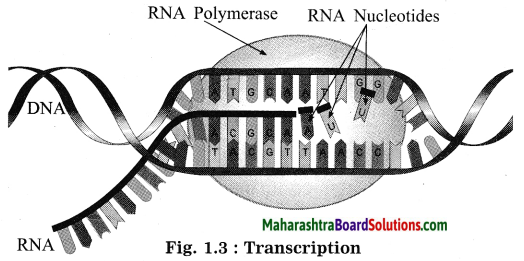
(1) What is the sequence of nucleotides present on one strand of the DNA?
Answer:
A T G C A A T T
(2) According to the above sequence on DNA, what will be the transcribed sequence on the mRNA molecule?
Answer:
U A C G U U A A
(3) Which enzyme is taking part in the above process of transcription?
Answer:
RNA polymerase takes part in the process of transcription.
![]()
Question 2.
Observe the figure 1.5 of translation and translocation, given on page 9 this chapter and answer the following questions:
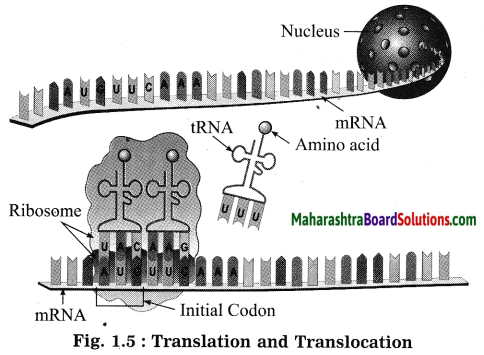
(1) Which is the initiation codon? Where is it present?
Answer:
AUG is the initiation codon, which is present on the mRNA.
(2) What are the types of RNA present inside the ribosome? Which triplet codon is present on it?
Answer:
There are two molecules of tRNA present inside the ribosome. The triplet codons present on them are UAC and AAG respectively.
(3) Which genetic code is present on mRNA that is leaving the nucleus? What must be the sequence on the DNA to have such code on mRNA?
Answer:
The mRNA that leaves the nucleus has genetic code: A U G U U C A A A
The genetic code on DNA therefore should be as follows: T A C A A G T T T
Question 3.
Observe the figure 1.6 given on page 10 from this chapter. Answer the following question based on your observations:
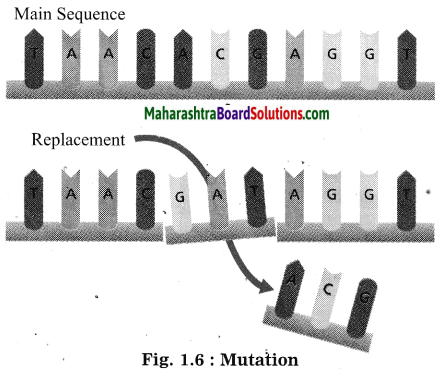
What is the significance of this figure from the viewpoint of evolution? Explain in brief.
Answer:
In the figure, the process of mutation is shown. The original nucleotide sequence of TGC is replaced by new mutated sequence GAT. The change in the nucleotide sequence will change the DNA.
This will result in the change in genes and then changing the hereditary characters. Due to such change in genes, the evolution proceeds. The mutation so formed can be minor or major. The greater the impact of the change, the evolution takes place rapidly. The mutation thereby produce recombinations leading to diversity.
Question 4.
Observe the picture and answer the following questions:
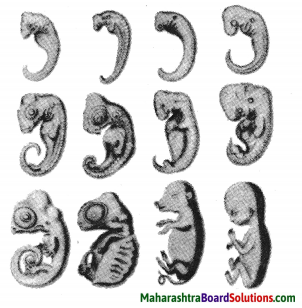
(1) Which evidence of evolution is shown in the picture?
Answer:
Embryological evidences of evolution are shown in this picture.
(2) What can be proven with this proof?
Answer:
The similarities in the initial embryonic stages of different vertebrates shows that there was a common origin of all of them. Thus embryological evidences prove that there was common vertebrate ancestor.
(3) Give one more example of evidence of evolution.
Answer:
Palaeontological evidences such as vestigial organs and connecting links are another examples of evolutionary evidences.
![]()
Question 5.
Which concept/theory do you remember after seeing this picture of Giraffes? Describe it in brief.
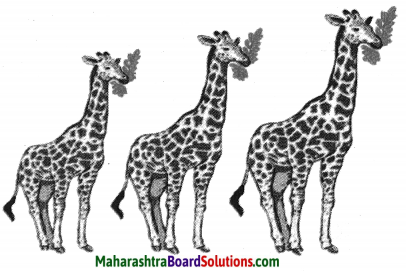
Answer:
- The picture is based on the Lamarck’s principle of ‘use and disuse of organs’.
- The morphological characters of organism develop because of specific activities that the organisms perform.
- If some organ is not used it gets degenerated. If excessively used, it develops further.
- Thus, the morphological changes take place due to activities or non-working of a particular body parts in an organism. Due to constant extension of neck to eat foliage from the top of the trees, giraffe’s neck became long.
Activity-based Questions:
Try this: (Text Book Page No. 4)
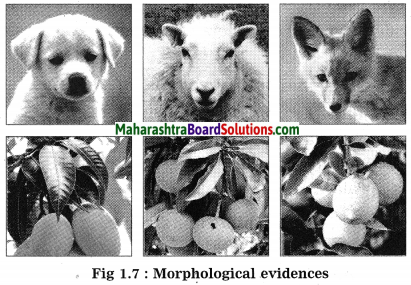
Observe the above images and note the similarities between given animal images and plant images.
Answer:
The above pictures of the animals show similarities such as structure of mouth, position of eyes, structure of nostrils and ear pinnae and body fur. In pictures of plants there are similarities in characters like leaf shape, leaf venation, leaf petiole, etc.
These above morphological evidences show that there may be a common ancestor for all of the species shown.
Observe and Discuss:
Question 1.
Observe the pictures given below. (Text Book Page No. 5)
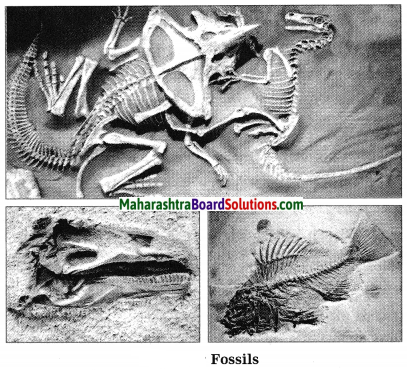
Answer:
(1) Fossils offer palaeontological evidence for the evolutionary process.
(2) Due to some natural calamities the organisms get buried during ancient times.
(3) The impressions and remnants of such organisms remain preserved underground. The hot lava also traps some organisms or their impressions. All such formations form fossils.
(4) Study of fossils help the researcher to understand the characteristics of the organisms that existed in the.past.
(5) Carbon dating method also helps in finding out exact age of the fossil. According to the structure of earth’s crust the fossils are obtained at specific depths.
(6) The oldest ones are obtained at the depth while the relatively recent ones occupy the upper surface. Thus fossils of invertebrates were seen in very old Palaeozoic era. Later were seen fossils of Pisces, Amphibia and Reptilia. The Mesozoic era was dominated by reptiles while Coenozoic era showed presence of mammals.
(7) In this way, study of fossils unfold the evolutionary secrets.
Question 2.
Observe the pictures given and discuss the characters observed. (Text Book Page No. 6)
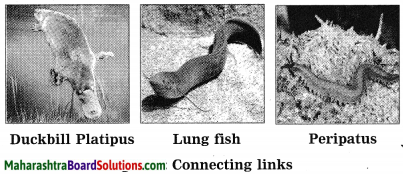
Answer:
Some living organisms possess some characters in them which are the distinctive features of different groups or phyla. Such individuals connect these two groups by sharing the characters of both and hence they are known as connective links.
Examples: (1) Peripatus: Peripatus is the connecting link between Annelida and Arthropoda. It shows characters of both animal phyla. Like annelid worm, it shows segmented body, thin cuticle and parapodia. Like an arthropod, it shows open circulatory system and tracheal system for respiration.
(2) Duck Billed platypus: This is a connecting link between reptiles and mammals. Like reptiles it lays eggs but like mammals it has mammary glands and hairy skin.
(3) Lung fish: Lung fish is a connecting link between fishes and amphibians. Though a fish, it shows lungs for respiration as in amphibian animals.
(4) Connecting links indicate the direction and hierarchy of evolution.
![]()
Project: (Do it your self)
Project 1.
Internet is my friend: (Text Book Page No. 3)
Collect the information from the internet about Big-Bang theory related with the formation of stars and planets and present it in your class.
Project 2.
Use of ICT: (Text Book Page No. 4)
Collect the information of geological dating and present it in the classroom.
Project 3.
Use of ICT: (Text Book Page No. 5)
Find how the vestigial organs in certain animals are functional in others. Present the information in your class and send it to others.
Project 4.
Internet is my friend: (Text Book Page No. 8)
Collect the pictures and information of various species of monkeys from internet.
Class 10 Questions And Answers
10th Std Science Part 2 Questions And Answers:
- Heredity and Evolution Class 10 Questions And Answers
- Life Processes in Living Organisms Part – 1 Class 10 Questions And Answers
- Life Processes in Living Organisms Part – 2 Class 10 Questions And Answers
- Environmental management Class 10 Questions And Answers
- Towards Green Energy Class 10 Questions And Answers
- Animal Classification Class 10 Questions And Answers
- Introduction to Microbiology Class 10 Questions And Answers
- Cell Biology and Biotechnology Class 10 Questions And Answers
- Social health Class 10 Questions And Answers
- Disaster Management Class 10 Questions And Answers
